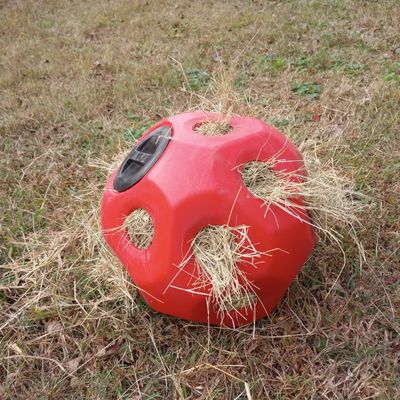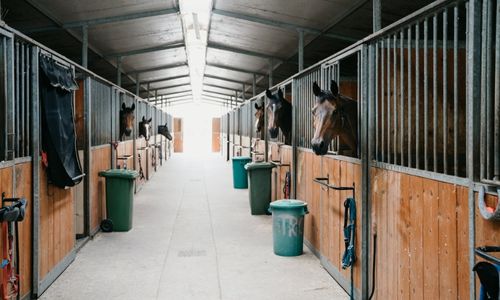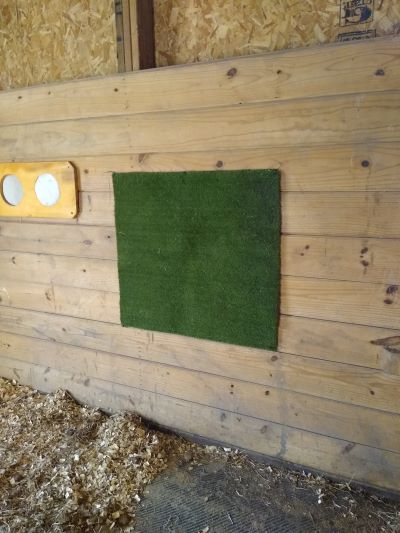If you have to keep your horse in a stall, creating the best environment possible is a must for preserving mental and physical health. There’s more to a good stall environment than popping in a toy or two and calling it done! In this article, we’ll cover enriched stalls for horses: what they are, the difference between an enriched environment and “boredom busters,” and why getting it right is crucial for your horse’s wellbeing.
What is Enrichment for Horses?
We usually think of enrichment as toys, or boredom busters. But there’s more to the idea of enrichment than colorful playthings or boredom relief for horses.
Enrichment goes deeper than that – it’s anything we do or provide that promotes species behavior. For horses, this means setting up the environment with objects or features that give horses the chance to do things like grazing, socializing, and moving long distances each day.

So an enriched environment is one that creates the opportunity for horses to act like horses. Enriched environments, indoor or out, contain enrichment that promotes natural equine behavior. This might include toys and treat items like webby balls or Lik-Its as well as environmental enrichment like sand stations.

For more on the basics of enrichment, visit this page.
What Counts as Stall Enrichment?
In brief, stall enrichment includes different objects and features that give your horse behavioral options during confinement. A stall without enrichment, by contrast, is very plain and manicured in appearance – the “normal” horse stall:

By contrast, enriched stalls usually feature:
- Forage available 24/7, such as in a slow feed net (find more on different hay nets in this guide)
- Food toys or puzzles given regularly during the day
- Ample bedding for comfort
- Sensory items that offer scents, sounds, or textures
- Self grooming devices like scratching pads

We’ll cover the elements of an enriched stall for horses in more detail below.
Why Does Behavior and Enrichment Matter?
We love to see horses playing with toys, rolling in sand, or grazing quietly with their friends. But sometimes we take for granted that these activities aren’t just “nice to have.” They’re a must for long term wellness.
Nowadays, we understand that all animals need the opportunity to use their bodies and minds to maintain their health. They also need mental and sensory stimulation.

A huge number of behavior issues and physical problems result from living in an environment and routine that doesn’t support natural behavior or provide stimulation for the mind and body. These include:
- Destructive habits like chewing, kicking walls, breaking equipment
- “Stall vices” like weaving, cribbing, stall walking
- Anxiety, hotheadedness, spooking
- Aggression and ugly attitudes
- Ulcers, other GI issues, and colic
- Hoof health issues
Much of the time, these issues are management related problems, meaning they stem from being in human care.
So What’s the Issue with Stalls?
The standard stall environment deprives horses of almost all their natural behaviors, and doesn’t offer stimulation for the sense and mind.
A horse’s stall will contain a water bucket, but everything else is discretionary. Bedding type and depth are up to the humans at the barn. We typically give a stalled horse hay, but usually in rationed amounts at set times. The stall walls might give horses a view of their next door neighbors – but they might not.
In this environment, there’s no opportunity for physical activity, natural behavior, or mental stimulation unless we take care to provide it.
In addition, there are many crucial behaviors that are simply impossible in a stall – most importantly walking and full-body contact with other horses. These behaviors aren’t “nice to have” activities for horses, but are crucial for wellbeing.

We might wish stalls were comfortable, well organized bedrooms for horses to relax and enjoy private time, but it’s important to accept that horses have very different needs than people.
For this reason, we need to acknowledge that stalls are not an appropriate long-term housing for healthy horses. Even an enriched stall can’t make up for the downsides of confinement. Horses need turnout – in a space that gives them opportunity for natural behaviors.
For more on creating enriched turnout spaces, visit this page.
Then Why Does Stall Enrichment Matter?
Stalls aren’t an appropriate long term housing option for healthy horses, but there are appropriate times to use stalls. During those times, enrichment gives back some of the behaviors and stimulation that horses require.
A serious injury may need months of full confinement for healing. Quarantine might cause your veterinarian to prescribe stall isolation. And in the shorter term, stalls are great for holding horses during unusual weather, construction, or preparing to ride and train.

Any time a horse will be in a stall for more than a couple hours at a time – with the exception of medical emergencies – enrichment becomes necessary.
The opportunity to eat, explore, rest, and take care of the body in natural ways is a must for reducing stress and keeping horses mentally well during long-term confinement. Enriched stalls can also make short stays very rewarding, turning a neutral or unpleasant stall stay into something special and fun.
Horses who will spend weeks in full stall care due to injury need the most enriched spaces, and rotation of some items each day to prevent boredom.
Plus, creating enriched stalls for horses is a lot of fun, and a chance to get creative. It feels great to put together an enriched stall and know that you’re making the environment better for your equine friend.
What is an enriched stall for horses?

An enriched stall looks more complex than a standard, bare box. Enriched stalls for horses contain items that promote these behaviors:
- Foraging (hay throughout day and night)
- Special feeding behaviors (treat feeding items)
- Grooming and self care (scratching options)
- Rolling, light sleep, and deep sleep (deep bedding)
- Using the senses (various sensory items)
- Using the mind (food puzzles)
- Socializing (contact with others, scents, mirrors)
- Object play (toys)
Enriched stalls for horses look more visually complex than a standard, bare stall because of the number of enrichment features they contain. But by creatively using the space including the walls, the stall isn’t cluttered or cramped with items.

“I added some horse boredom busters. Am I done?”
Enriched stalls for horses involve much more than chucking in a few toys and calling it a day. As you can see from the list above, stall enrichment is a broad topic and it takes a lot of different items to make a conventional stall more appropriate for horses.
Toys in the typical sense encourage exploration and play, which are wonderful – but they aren’t the whole picture.

In addition, any toy or boredom buster for horses will lose its novelty after a short period. Just like we don’t want to do the same activity all day every day, horses need options and a changing environment.
How to Create an Enriched Stall for Horses
To create an enriched stall for your horse, plan to encourage each of the behaviors above by adding permanent enrichment as well as temporary boredom busters.
The specific enrichment items you use will vary based on your horse’s needs and your stable environment. For instance, if your stable features half wall partitions that let your horse touch and groom their neighbor, other forms of social enrichment are less crucial.
Add items and equipment with safety in mind, including your individual horse’s temperament. Enrichment safety is paramount especially when horses are in enclosed spaces with enrichment items.

Remember to site items where your horse can use them, and to use the entire stall space if possible. You’ll want to leave the floor space clear for moving around and resting, but the walls are fair game.
Some equipment needs to be used at a certain height (like scratch pads, which should be at mid-body height), but many toys can be attached to the walls at different heights to change how they’re used.
Rotation and Variety in Enriched Stalls for Horses
Horses confined to stalls full time need variety and stimulation as well as behavior-encouraging, boredom-preventing enrichment. Even the most engaging toy can lose its charm if it’s all the horse has in their space, and food-based enrichment like snuffle mats for horses need to be switched out as the horse finds and eats all the goodies.

The best way to provide interest and variety over the long term is by giving different enrichment each day, and sometimes more than once a day.
Whether you buy your horse’s toys or make your own DIY enrichment, a well stocked “toybox” lets your bring fresh enrichment items into the stall and remove the old ones.
Rotating the physical location of toys that attach to walls is also helpful. A puzzle feeder may be used on the front wall one day, and that same spot used the following day for the hay net, etc.
Sensory enrichment also needs regular changes. If you use music or recorded sounds as stable enrichment, switch the playlist every few days. Change the scents in your horse’s stall scent board daily, and so on.
Some items can’t or shouldn’t move around the stall. Scratching board or stall scratch pads and wall mounted hay feeders are a great example of permanent stall enrichments. Once you invest in these products, they benefit your horse without any further time and work.
Making a Plan for Enriched Stalls

To keep up constant change and variety when a horse needs intensive enrichment care, an enrichment schedule or plan is very useful.
An enrichment schedule is a lot like a class agenda, or a cafeteria menu – it lets you plan in advance what enrichment you’ll provide each day.
Planning enrichment for your stalled horse by the week is a great way to avoid overusing toys or puzzles, and to remind yourself to add or change sensory items.
To make an enrichment plan, you can use a paper planner (the 2023 Enriching Equines training planners on Amazon have space for enrichment!) or an online spreadsheet. An inexpensive dry-erase board on the stall wall is a low profile way to make notes about what your horse needs each day – perfect for stall confinement at boarding stables.
Enriched stalls for horses:. Making the best of the situation
The stall will never be an ideal environment for horses, but with well-intentioned enrichment and dedication to providing a daily routine, we can make stalls much better for our horses’ mental well-being.
The keys to creating a successful enriched stall for horses are supporting as many of a horse’s natural behaviors as possible through creative use of equipment and design. Then, promote mental wellness with rotation and variety.
Stall Enrichment Ideas
You’ll find the full gallery of enrichment ideas that can be used in stalls in the Stall Enrichment post collection!
Some must-have features:
Slow Feed Mats (DIY version) for grain and pelleted feeds